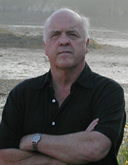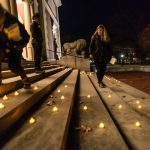In a letter to the Bowdoin community, President Barry Mills and Dean for Academic Affairs Cristle Collins Judd remember Thomas Cornell, Bowdoin’s Richard E. Steele Artist-in-Residence Emeritus, who died December 7, 2012, sharing reflections on the life of this accomplished artist and the 50 years Cornell devoted to the College.
To Members of the Bowdoin Community,
As many of you know, Thomas Browne Cornell, Bowdoin’s Richard E. Steele Artist-in-Residence Emeritus, passed away Friday evening, December 7, 2012, following a long and courageous struggle with cancer. Tom was an important figure at Bowdoin for a half-century, having just retired in June. During his impressive career, Tom established an international reputation as an artist whose drawings, etchings, and paintings demonstrated his passion for the philosophical and psychological tensions that exist within individuals and that are reflected in the relationships between human beings and nature.
Tom was born in Cleveland, Ohio, on March 1, 1937. He earned his undergraduate degree at Amherst College in 1959 and later studied at the Yale School of Art and Architecture. Tom began his teaching career at the University of California in Santa Barbara in 1960. Two years later, he accepted an invitation to establish a program in visual arts at Bowdoin. Tom also served as a lecturer at Princeton University (1969-71) and directed the Summer Art School at Massa Lubrense in Sorrento, Italy, in 1967. At Bowdoin he was promoted to assistant professor in 1963, associate professor in 1969, full professor in 1975, and was named Richard E. Steele Professor of Studio Art in 2001. In 2008, Tom was named Richard E. Steele Artist-in-Residence. He was named Richard E. Steele Artist-in-Residence Emeritus upon his retirement earlier this year. For most of his time at the College, Tom was also a regular presence and strong competitor on Bowdoin’s squash courts.
Tom was best known early in his career for his drawings and etchings, including the series of 21 portraits of important figures in the French Revolution for Gahenna Press’s The Defense of Gracchus Babeuf, along with images of abolitionist Frederick Douglass and civil rights leader Bayard Rustin. He turned to painting for his triptych The Dance of Death (a commentary on the war in Vietnam), for a series of paintings on The Birth of Nature, and for a commission of large paintings on The Four Ages for the John Hancock Life Insurance Company.
Tom’s work has been featured in nearly 20 solo exhibitions and five dozen group exhibitions, including the first group exhibition of American art shown in the Soviet Union in 1989. His essays about his art provide invaluable insights into the complex intersection of intentionality and vision in the mind of a remarkable artist. Tom continued to be a source of creativity throughout his career; his painting Dependency on Nature and the Death of War was shown this year at the The Annual: 2012 exhibit at the National Academy Museum & School in New York. As part of the museum’s renovation, Tom’s name, along with other National Academy members, is carved into the ceiling of the building’s entrance.
Tom’s works may be found in prominent collections of art, including those of the Museum of Modern Art, Harvard University, Princeton University, the Beinicke Library at Yale University, the Cleveland Museum of Art, the New York Public Library, the Bibliothèque Nationale in Paris, the Mitsubishi Corporation, and the National Museum of American Art, as well as in many private collections. He was the recipient of many fellowships, grants, and awards over the course of his career, was elected to the National Academy of Design in 1984, and also served as president of the Union of Maine Visual Artists.
Throughout his career, Tom infused his art with optimism and with the belief that meaningful interaction with nature and the environment may provoke positive changes in humanity. He was an inspiring teacher, a mentor to many young artists, and a passionate advocate for art as a way to promote service to the common good. Recurring themes in his work are declarations against war and the healing power of familial love and affection, particularly between fathers and children. As he explained it: “If the father can see himself as playing with children, he’s not going to be as willing to be a warrior.” We are grateful for Tom’s artistic legacy-one that will continue to enrich and challenge us for years to come.
We share in the sorrow of Tom’s passing with his colleagues, friends, and family, including his wife, Christa K. Cornell (a member of the Bowdoin Class of 1975), his daughters Olivia and Diana; and his son, Nicholas.
A memorial service for Tom Cornell will be held on Saturday, December 15, at 3:00 p.m., in the Bowdoin Chapel. Memorial contributions may be made in support of student financial aid at Bowdoin College (4100 College Station, Brunswick, ME 04011-8432).
Tom was a major presence on our campus and within the art world for many, many years. We already miss his extraordinary talent and his deep devotion to our College and to generations of students. Our community of scholars is diminished today with Tom’s passing, but we are all enriched by the legacy of the optimism and the art that he leaves behind.
Sincerely,
Barry Mills and Cristle Collins Judd

